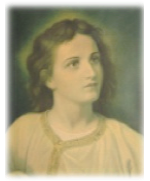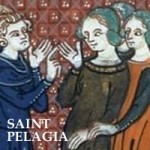5th Resumed Sunday after Epiphany
Beloved in the Lord,
In the ancient Jewish temple, sacrifices of animals were central to worship. We know, that these sacrifices prefigured the ultimate sacrifice of Jesus Christ on the cross. The lambs that were offered for example, prefigured the ‘Lamb of God,’.
.
Now it is a very interesting and rarely discussed fact, that when those animals were slaughtered and cut into pieces, as part of the ritual, the priest would then arrange the pieces back together, ‘re-forming’ the animal, if you will. Why? Well, it was part of their rules of the ritual – they may not have understood it, but it actually pre-figured the resurrection, when Jesus crucified, would be re-constituted in his body, alive.
.
Now the Holy Mass is the re-presentation of the life, death, and resurrection of Jesus Christ. Various parts of Holy Mass have symbolic meaning; for example at the Consecration, and when the priest raises the Host and the Chalice, we are at the Cross – it is quite clear here, because we look at the Host and the Crucifix really, together. And if the Consecration signifies the death of Christ, Holy Communion is linked to his Resurrection.
.
At Communion time, when the priest breaks the Host over the chalice – and we might think of the tomb breaking open – after that is a strict requirement in the Latin Mass, that after that Host is broken, the two halves of the host are placed on the paten, and fitted exactly back together. If then, at the Consecration, the separation of Body and Blood signifies Christ’s death, then this re-assembling of the Host signifies his glorious resurrection.
.
And as for us – the fathers of the Church from the beginning called Holy Communion the ‘Secret of the Resurrection.’ Holy Communion is the antidote to death. Jesus said, ‘He who eats this bread will live forever.’ Our Lord spoke of the resurrection of the body on numerous occasions; John, 6:39 – This is the will of him who sent me, that I shall lose none of all those he has given me, but I will raise them up on the last day. Verse 40: Every one who believes in the Son – I will raise them up on the last day. verse 43: ‘And I will raise them up on the last day.’
.
When Jesus raised the boy from the dead, when he raised the little girl from the dead, and Lazarus too – these are all indicating the ultimate resurrection of the body. The Sadducees challenged Christ on the question of the resurrection – since they did not believe in it. The Sadducees did not believe in the resurrection, or in angels, they accepted only the 1st 5 books of the bible – not the prophets or wisdom books or anything else. But Our Lord quotes to them from the Book of Exodus – which the Sadducees accept! Christ replies, ‘have you not read – where the Lord says, I am the God of Abraham, the God of Isaac, and the God of Jacob. Notice, it doesn’t say: I WAS the God of Abraham, Isaac, and Jacob, he says, I AM the God of Abraham, Isaac, and Jacob. Because, Abraham, Isaac, and Jacob – aren’t dead. They’re alive. It’s brilliant – Our Lord shows them that even way back in the Book of Exodus, the resurrection is indicated.
.
So how many people these days are still Sadducees, who do not really believe that on that Great Day, we will be resurrected, alive, in our glorious bodies? No wonder people only live for transitory pleasures. The great secret for us Christians, is the resurrection. Not only Jesus rose from the dead, but we will too. This is why its called, the Good News! It’s why Jesus came. Jesus was born, he grew up, he worked; he died – and he rose in his glorified body, and ascended to Paradise. We are his followers. We are born, we grow up, we work and suffer and die. And we will rise, in glorified bodies and enter paradise. This is why Jesus is called the First-born from the dead – because he went first; he conquered death and we will follow.
.
Where do we get this power, to rise from the dead? The power comes to us from Jesus Christ, mediated through the sacraments, beginning in Baptism, but so much in Holy Communion. As I said, the early Christians called the Eucharist the ‘antidote’ to death. ‘Here, eat this, and you will survive death.’ They risked their life to get to Holy Mass, because our eternal life is at stake. This is why the martyrs were not afraid of death. Its why in the book of Macabbees, we see a whole family, urged on by their mother, give their life for the Faith. They believed that God will raise them up, and it’s why we are not afraid to die.
.
St. Ambrose explains, that death entered the world so that sin might come to an end. He says: Death was to bring an end to guilt; the resurrection enables our nature to continue forever. St. Paul says, ‘Behold, I tell you a mystery: we shall all rise, in the twinkling of an eye. At the last trumpet, the dead will rise, and we shall be changed. At the little cemetery up at Mundelein, there is a very cool statue of an angel blowing a trumpet. This signifies the end of the world and the resurrection of the body.
.
There seems to be one main reason people are unhappy today. They don’t really believe in the resurrection of their body. They seem unsure of what the next life will bring. Friends, if a Catholic does not believe in the resurrection of their body, they are rejecting a central teaching of our Faith. Every Sunday we say in the Creed: ‘Expecto resurrectionem mortuorum, et vitam venturi saeculi.’ I await the Resurrection of the Dead, and the Life of the world to come. This changes everything about our life. It makes life worth living.
.
As St. Paul says, if there is no resurrection of the dead, then our faith is worthless. But Christ has indeed been raised, he is the first, we follow him. As scripture says, ‘since death came through one man, Adam, so the resurrection of the dead comes also through one Man, Jesus.
.
A few years ago we were burying a woman at Rosehill cemetery – it’s a big cemetery. After the prayers, as the people dispersed, a mother and her children walked over to chat with me, it turns out that the deceased was a very dear aunt to the children, Aunt Anne. They looked at me with their sad little hearts, so I said to them: ‘Do you kids want to hear a secret? ‘Look out at this vast cemetery. You see all those thousands of graves and tombs there? Their eyes scanned the rolling hills, the myriad of tombstones. ‘Those graves are all people who are waiting. And at the end of the world Jesus is going to wake everyone up and have them go to paradise with him, and it will be the happiest day in the world. ‘They will be alive,’ they asked? ‘Yes, I said, very alive.’ ‘Even Aunt Anne? Even Aunt Anne. And they were very happy, because they had faith in the power of God.
.
You know, the word ‘death’ was rarely used by early Christians.[i] They said, the person has ‘fallen asleep.’ We say that in the Canon of the Mass as well. In fact, the word ‘cemetery,’ comes from the Greek word[ii] which means ‘sleeping place’ – The cemetery is a sleeping place, until the resurrection.[iii]
.
If someone said to us, at a certain hour a dead person will be raised to life, we would run very quickly to see it.[iv] Well, if you are a faithful Christian, you will one day not only see ‘some’ person raised, you will be raised.
.
Let us then ask Mary to help us in our faith – Mary, help us to live and believe as true Christians, and one day be worthy of the resurrection of the dead, and the life of the world to come. Amen. +
.
[Entrusted to the prayers of St. Peter]
.
[i] ‘The Histor of the Mass and its Ceremonies in the Eastern and Western Church’ – John O’Brien, p. 344.
[ii] (dormitory(κοιμητήριον)).
[iii] And also, in Germany of old, people saw the body placed in the ground
to be like the seed sown by a farmer awaiting growth.
Even grave stones were compared to those little signs
that a farmer places, to show what type of flower or plant is planted there.
In those days, words for burying a person in the grave
conveyed the idea of hiding a treasure until the future.
[iv] Little Catechism, p. 38.


